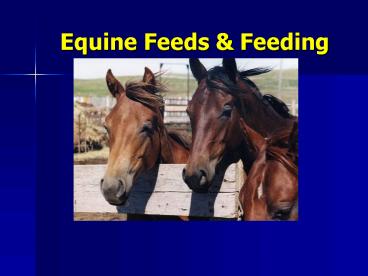Equine Feeds - PowerPoint PPT Presentation
1 / 26
Title:
Equine Feeds
Description:
Add protein and minerals if needed. Consider adding vitamins and ... Birds Foot trefoil. Clovers. Lespedeza. Hays Nutritive Value & Palatability. Plant species ... – PowerPoint PPT presentation
Number of Views:405
Avg rating:3.0/5.0
Title: Equine Feeds
1
Equine Feeds Feeding
2
(No Transcript)
3
Building a Horse Ration
- Start with horse needs
- Maximize forage
- Add energy if needed
- Add protein and minerals if needed
- Consider adding vitamins and supplements
Feed concentrate that makes-up the difference
between nutrients needed nutrients in roughage
4
HAY OR PASTURE
- Foundation for every feeding program.
- Adequate chewing time
- Energy
- Aids in proper transit thorough GI tract
- Main substrate for bacterial digestion in the
cecum - Indigestible parts provide scratch factors
prevent wood chewing
5
What is forage?
- Min. fiber content of 18 relatively low
dietary energy - Cell walls cellulose, hemi cellulose, lignin
(0 digested) - Cell contents protein, soluble carbohydrates,
ether extract, ash
6
Forages
- Legume
- Alfalfa
- Birds Foot trefoil
- Clovers
- Lespedeza
- Grass
- Bromegrass
- Orchardgrass
- Tall Fescue
- Timothy
- Grain Hay
- Oat Hay
- Wheat hay
- Straw
7
Hays Nutritive Value Palatability
- Plant species
- Level of maturity at harvest
- Weed content
- Growing conditions
- Curing harvesting conditions
8
Hays Nutritive Value Palatability
- Soil conditions fertility
- Moisture content
- Length method of storage
9
Supplement Energy?
- Concentrates often needed -
- Late gestation
- Lactation
- Growth
- Work
10
Energy Sources Comparative Values
11
Energy Sources Comparative Values
12
Crude Fiber DE Relation of Commonly Fed Feeds
13
Relationship of Crude Fiber to Expected DE
14
Protein
- Needed for muscle bone growth, milk
production, fetal growth, normal metabolism - Requirements can be met with good quality hay or
pasture forage - Low requirements for maintenance
- Quality amino acid balance
- Very important for young horses
- Lysine, methionine, tryptophan most limiting for
growth milk production
15
Comparison Protein Supplements
16
Minerals
- Content in the diet will be determined by soil
water in area - Quality of feed and proportion of grain to hay
- Ca and P
- Continuous loss
- 70 of the mineral content of the body
- 99 of the Ca and 80 of the P in bones and teeth
- 1.12.0 parts Ca to 1.0 part P is ideal
- Quality forages usually provide adequate Ca P
17
Minerals
- Potassium, Magnesium, Sulfur
- Supplement as a group - use one
- quantities are additive - toxicities possible
- Keep in the proper ratios
- Salt (NaCl)
- .5-1.0 added
- 60 g/d
- Free choice
- Either in block form or loose
18
Trace Minerals
- Look for iron, zinc, copper
- Ratios affect absorption of all
- Toxicities often seen with iron and selenium
19
Adequate Minerals
20
Trace Mineralized Salt
- 98 sodium chloride
- Zn 0.1-0.35
- Manganese 0.20-0.28
- Iron 0.15-0.35
- Copper 0.02-0.04
- Cobalt 0.05-0.007
- Iodine 0.007
- TMS containing high levels of Cu (0.25), Zinc
(0.75) and/or selenium (0.0025) is available.
21
Vitamins
- Fat soluble
- stored in body - A, D, E, K
- Toxicitys can occur if fed in excess
- Water soluble
- must be continuously supplied
- B-complex niacin, thiamin, riboflavin
22
Adequate Vitamins
- High quality fresh forages maintenance for
mature horses - Hay is poor in Vit A. Supplement Vit A in the
ration - Exposure to sunlight provides Vit D
- Vit. E is important for reproduction, performance
horses, prevention of white muscle disease,
equine degenerative myeloencephalopathy (EDM),
and equine motor neuron disease (EMND) - Vit B is synthesized in the horses cecum
23
Vitamin/ Mineral Combinations
- A, D, E, K - Stored in fat - potentially toxic
- C, B complex - water soluble
- Blood builders - mostly iron
- Vitamins easily destroyed by heat, copper and
iron, dampness, and high oil levels - Biotin/methionine - sulfur - hoof growth
24
Feeding Horses
- Feed intake usually expressed as
- of Body Weight
- Lbs feed/100 lbs body weight
- Free Choice
- Min. 1 BW as forage
- Grains provide 50-60 more DE than forage
- Vegetable oils animal fats provide 2.25x more
energy then grain - No more than 10-15 of total diet
25
Expected feed consumption BW
26
Remember
- Make educated decisions
- Feed by weight not by volume
- All feed should be clean of mold, dust, etc.
- Feed at regular intervals
- 12 hours
- Make gradual changes in feeding program
- Safer to increase hay then grain

